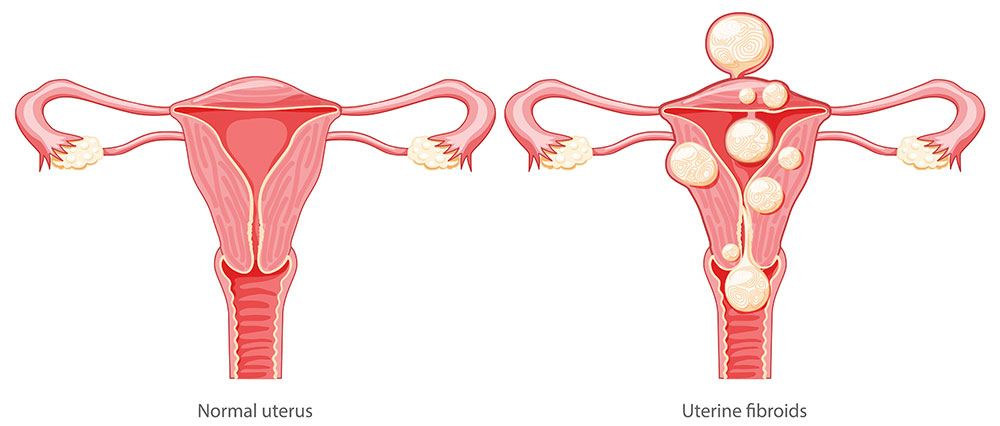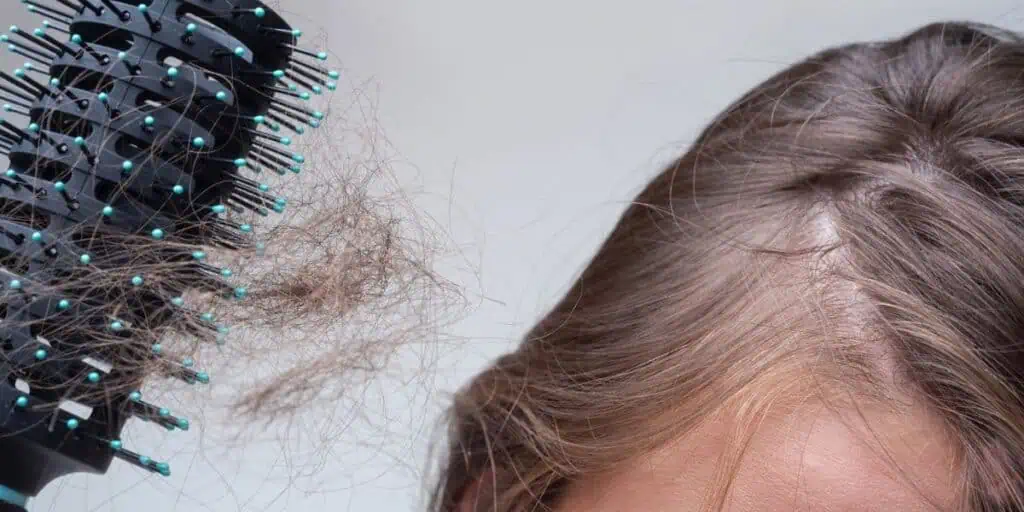What is myomectomy (uterine fibroid removal surgery)?
Uterine fibroids (myomas) are smooth, benign tumors that grow in the uterus. A myomectomy is a surgical technique that removes fibroids, improving fertility and eliminating or significantly reducing symptoms.
When is a myomectomy performed?
While fibroids are almost always benign, they can significantly impact your quality of life.
A myomectomy can treat the following fibroid symptoms:
- anemia
- abnormal uterine bleeding
- menorrhagia (heavy menstrual periods)
- pelvic pain and pressure that cannot be managed with medication
- infertility or recurring miscarriages
- frequent urination
A myomectomy may also be performed if you plan to bear children and our doctor suspects uterine fibroids might be interfering with your fertility.
Unlike a hysterectomy (removal of the uterus), a myomectomy leaves the uterus intact, making it a popular choice among patients who still wish to get pregnant.

What are the types of myomectomy surgeries?
The method your surgeon chooses may depend on the number, size, and location of the fibroids. For surgery, you will be under general anesthesia or otherwise sedated for your comfort.
Mini laparoscopic (MiniLap) myomectomy
Mini laparoscopy myomectomy is a less invasive treatment option performed through several small incisions in the abdomen. Dr. Aliabadi inserts a thin, flexible laparoscope into an incision and views the organs through a special lens at the end of the instrument.
Laparoscopy is typically used by other surgeons when only one or two fibroids need to be removed and if they are less than two inches in diameter. However, Dr. Aliabadi specializes in minimally invasive laparoscopic surgery and can safely remove fibroids of any size with this procedure, with minimal pain, essentially no scarring, and reduced downtime.
For more information about our advanced outpatient surgical procedures, please visit our Outpatient Hysterectomy Center website.
In the following videos, Dr. Aliabadi performs an outpatient hysterectomy on Sheila, who was suffering from fibroids. Watch Sheila’s story and her amazing recovery.
Abdominal myomectomy
While Dr. A’s surgical expertise enables her to perform all myomectomies laparoscopically, many surgeons opt for a traditional “open surgery” when faced with very large or multiple fibroids.
In this most invasive procedure, your surgeon makes a large incision in the abdominal wall. The horizontal incision is in the lower abdomen, around the same location as a C-section incision. This provides a clear view of your pelvic organs, allowing the surgeon to remove the tissue through the incision. Some surgeons find this to be a better option if there are multiple fibroids or if they are deeply embedded in the uterine wall.
Minimally invasive fibroid treatment options: non-surgical treatment options
In some cases, minimally invasive treatment options are available. These treatments vary depending on individual health factors, the size and number of fibroid growths, and whether future pregnancies are desired. They include:
Hysteroscopic myomectomy
This is primarily used for submucous myomas that grow inside the uterine cavity.
Hysteroscopic surgery is performed through the vagina and cervix. After cervical dilatation, the doctor inserts a hysteroscope to view the inside of the uterus. A wire loop resectoscope cuts the fibroid with electricity, and the surgeon then removes it through the vagina.
Uterine artery embolization (UAE) /uterine fibroid embolization (UFE)
Uterine artery embolization works by blocking blood flow to the uterine fibroids through tiny particles injected into the uterine arteries. This causes the fibroids to shrink and die due to a lack of blood supply.
Radiofrequency volumetric thermal ablation (RVTA)
Radiofrequency energy is used to ablate fibroids, wearing them away through friction or heat, for instance, guided by an ultrasound probe.
MRI-guided focused ultrasound surgery (MRgFUS)
A heat source is used to ablate fibroids, guided by magnetic resonance imaging (MRI).
What are the risks of myomectomy?
All surgical procedures carry some risk, but with an experienced surgeon, the risks are significantly minimized. Your doctor will explain the risks to you and take every precaution to ensure your safety during surgery. Risks of fibroid surgery include:
- Damage to pelvic tissue (uterus, fallopian tubes, ovaries, bladder, bowels)
- Scar tissue (adhesions) that may cause pain or infertility
- Scarring that may rupture during pregnancy or childbirth
- Infection of the ovaries, fallopian tubes, or uterus
- Intraoperative blood loss or heavy bleeding
What is the myomectomy recovery time?

Your recovery from a myomectomy depends on the type of surgery you have had. For the best recovery outcome, attend all follow-up appointments and contact your OB/GYN with any problems or concerns.
- Abdominal — 1-3 days in the hospital, 4-6 weeks recovery
- Mini laparoscopy — No hospital stay, 1-2 weeks recovery
- Hysteroscopy — No hospital stay, 3-14 days recovery
Dr. Aliabadi will discuss when you can return to normal activity.
It’s relatively common for fibroids to return even after a myomectomy. Experts estimate that between 1 and 5 out of every 10 women who have a myomectomy will experience recurring uterine fibroids. If you have multiple or large fibroids, you are more likely to have more uterine fibroids return.
Will a myomectomy affect future pregnancies?
Patients who have a myomectomy to improve their chances of having a baby should try to get pregnant soon after the surgery. This is because the odds of fibroids redeveloping increase over time.
If you get pregnant following a myomectomy, there’s a slightly increased risk of complications involving the placenta, such as placenta abruption or placenta accreta. Because of this, delivery via Cesarean section is recommended.
Have more questions about myomectomy surgery? Make an appointment with Dr. Aliabadi — LA’s best myomectomy surgeon
As one of the nation’s leading gynecologists and gynecologic surgeons, Dr. Thaïs Aliabadi provides the highest standards in women’s health and well-being. With her warm and professional team, Dr. Aliabadi supports women from puberty through pregnancy, childbirth, menopause, and beyond. She fosters a special one-on-one relationship between patient and doctor.
Highly trained and honored by the medical community, Dr. Thais Aliabadi is certified by the American Board of Obstetrics and Gynecology and a Diplomat of the American College of Obstetrics and Gynecology. She implements the most advanced, state-of-the-art technology and treatment options, creating personalized treatment plans tailored to each patient.
Dr. Aliabadi specializes in up-to-date, minimally invasive gynecologic surgery techniques for fibroid care, polyps, and endometriosis, which promise her patients shorter recovery times, reduced pain, and minimal interruption to their daily lives.
We also invite you to establish care with Dr. Aliabadi. Please make an appointment online or call us at (844) 863-6700 for general inquiries.
Dr. Thais Aliabadi is a member of the American College of Obstetricians and Gynecologists. Her practice is conveniently located for patients throughout Southern California and the Los Angeles area. We are located in Beverly Hills, near West Hollywood, Santa Monica, West Los Angeles, Culver City, Hollywood, Venice, Marina del Rey, Malibu, Manhattan Beach, and Downtown Los Angeles.
Sources
Wamsteker K, Emanuel MH, de Kruif JH. Transcervical hysteroscopic resection of submucous fibroids for abnormal uterine bleeding: results regarding the degree of intramural extension. Obstet Gynecol 1993; 82:736.
https://pubmed.ncbi.nlm.nih.gov/8414318/
Knuttinen M-G, et al. ACR Appropriateness Criteria Radiologic management of uterine leiomyomas. Journal of the American College of Radiology
https://pubmed.ncbi.nlm.nih.gov/29724419/
Lonnerfors C. Robot-assisted myomectomy. Best Practice & Research: Clinical Obstetrics and Gynaecology.
https://pubmed.ncbi.nlm.nih.gov/29103894/
















